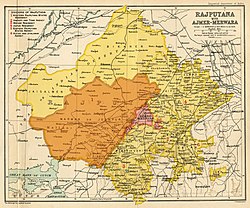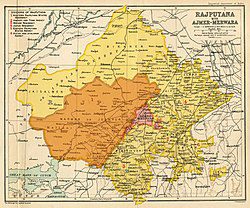The Land of Maroowar (Marwar) is the adobe of one of the bravest clans of Rajputana. Known as the Land of the Death due to its inhospitable barren desert and where all hopes of sustaining a normal life shattered, it was once the home of the mighty Rathors.

The Rathore kingdom of Marwar comprised the regions like Jodhpur, Nagaur, Barmer, Pali, Ajmer and Jalor. The Kingdom of Marwar had a fascinating history.
Their land although located in a difficult habitat produced some of the greatest warriors and indian and Rajput history. Men like Durgadas Rathore, Maharaja Jaswant Singh, Rao Jodha, Maldev Rathore, etc all belonged to this prestigious and illustrious Rajput clan.

They had fought countless battles and unfurled their Panchranga (flag with five colors) flag in every corner of the country. In this article, we will delve into the early history of Marwar and their initial rulers which laid the foundation of one of the bravest kingdoms of Rajputana.
The Inception of Rathors: History of Marwar Kingdom
The word Rathore is believed to be derived from the Sanskrit word Rashtrakuta the empire that rose to prominence during the famous tripartite struggle of Kannauj. However, the origin of the Rathore clan is still ambiguous and shrouded in historical texts.
Several historians have presented their theories regarding this clan’s origin and existence. Scholars and historians like Gopinath Sharma, G.S.Ojha, Colonel James Tod, and others have given their viewpoints in their writings regarding Rathor’s origin.
Col.Tod had written a lot about the history of Rajputana and according to him, the Rathors claimed their ancestry from the Suryavanshi clan.
On the other hand, Gopinath Sharma had called Rathore the descendants of the Rashtrakuta Empire. Another belief regarding their origin is that they were the descendants of the Gahadawalas of Kannauj.
It is suggested that after the fall of the kingdom of the Gahadawalas in the battle of Chandawar in 1194 its people migrated to different parts of the country. One branch reached Gujarat under the leadership of a person named Sihoji (Rao Siha Rathore) who is believed to be the grandson of Raja Jaichand.
At Gujarat, they were warmly welcomed by the Solanki Rajputs. The generous behavior of Bhim Dev II the Solanki king was duly appreciated by the visitors and it is believed that Rahtore joined their service for some time.
Together with the Solankis the Rathors counters the invasions of the neighboring tribes.
Note: According to Col.Tod and Muhnot Nainsi Sihoji was the son of Setram and they traced their lineage from the Gahadawala of Kannauj.
Later, Sihoji (r1240-73) established himself in and around the Pali district of Rajasthan region where Paliwal Brahman also aided the Rathores.
Note: An inscription that has been recovered from the Pali districts tells us about Sihoji and military conquests.
Here too the Rathore clansmen fought the native tribes like Meenas and Mers which constantly raided their lands. Later his son set up different branches at several places. For example, Asthan the first son of Sihoji succeeded his father while his brother took the region of Idar and Okha.
They made themselves the master of Barmer and this region for many years served as the capital of Rathors. Later Rao Duhad the son and successor of Asthan made many unsuccessful attempts to capture the region of Mandor.
The attempts made by the Rathors to subjugate the fortress of Mandor proved very costly. The Purihar dynasty which was the master of Mandor proved to be a tough opponent for the Rathors.
But the fortune of the Rathors finally took a huge turn in the early 15th century when Rao Chunda the later king of the dynasty finally conquered the land of Mandor and established Rathore supremacy over it.
LIKE WHAT WE ARE DOING? DONATE TO DHARMAYUDH
If you support what we are doing and would like to contribute to help us grow and reach more Indians to teach them more about such forgotten historic Indian Heroes and stories, please consider donating any amount. It will help us grow.

